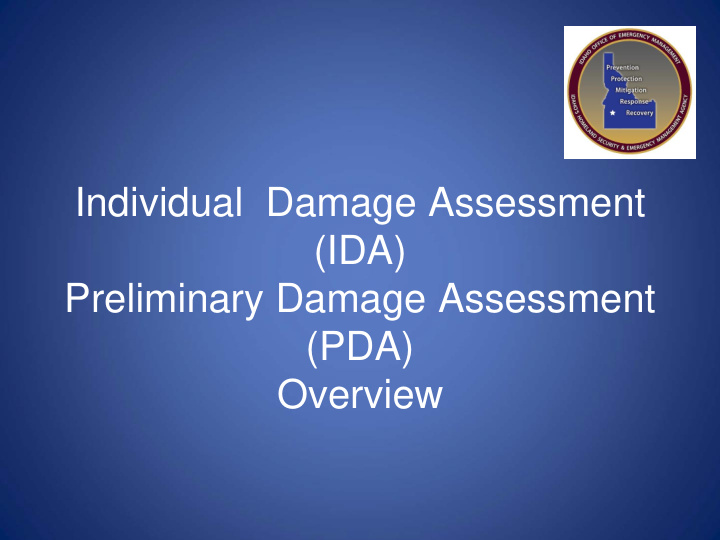



Individual Damage Assessment (IDA) Preliminary Damage Assessment (PDA) Overview
IDA / PDATraining 1.Individual Assistance Initial Damage Assessment (IDA) and Joint State/FEMA Preliminary Damage Assessment (PDA) Overview 2.Process and Methods of the IDA including when to conduct the IDA and what information to capture 3.Promising practices – Whole Community Engagement 4.Opportunity to practice
Timeline of Emergency Management Phases
Types of Disasters • Undeclared • Most common type of Disaster • State Declared • Beyond the local community’s capacity • Federally Declared Disasters and Emergencies • The Robert T. Stafford Disaster Relief and Emergency Assistance Act (the Stafford Act) • Beyond the State’s or Tribe’s capacity
County Map Current Disasters
Evaluation Factors for the Individual Assistance Program • Concentration of damage • Trauma • Special Populations • Voluntary AgencyAssistance • Insurance • Other considerations
Damage Assessments Step One --- Initial Damage Assessment (IDA) Step T wo --- Joint Preliminary Damage Assessment (PDA)
IDA Information Collected Residential Damage • Disaster Related Damage • Not Pre-Existing Condition • Impacts Livability of Dwelling • Must be Primary Residence • Identifies Occupancy Basis Other Information • Insurance • Low Income Households • Inaccessible Properties
Damage Definitions • DESTROYED • MAJOR • MINOR • AFFECTED
7 • Flood • MH • Own • Major • Not Insured • Low Income
• Winter Storm • SF • Own • Affected / Minor • Insured • Low Income
Remember Safety First!
What a PDA “Is” and “Is Not” A PDA “IS” A PDA “IS NOT” • Snapshot of • Does Not Determine Residential Damage Eligibility • Business and • Does Not Capture All Economic Losses Damage • Paints a Picture of • Does not include Cosmetic/Non Essential Community Repairs • Includes Statistical and Narrative Data June 2012
PDA Purpose • Document Severity of Damage • Assess Impact on Communities • Estimate Uninsured Losses • Identify Disaster Specific Issues • Estimate Funding Requirements • Foundation for Governor’s or Tribe’s Request • Support FEMARecommendation • Important first step in the Declaration Process 61
PDA TeamMembers • Local Representative • State Representative • Tribal Representative • FEMAIndividualAssistance • SBA Representative • Other Team Members? • VOAD/ARC • Hazard Mitigation • USDA • PIO
Daily TeamActivities • Assess Damage to Homes and Businesses in an AssignedArea • Determines Insurance, Demographics • Reaches Consensus between FEMA/State/Tribe • Provides Daily Tallies/Reports • Debriefs on Outstanding Issues
Key Points for PDA ▪ Safety of Participants ▪ Timeliness/Relevance ▪ Accuracy/Thoroughness ▪ Consensus between FEMA/State/Tribe ▪ Participation by Local/State/Tribal Officials
Use of PDA Data • Results of the PDA are compiled/tallied and a narrative is drafted to include outline of impact to the community • PDA data is available to State, Tribe, and FEMA Region • State/Tribe/FEMA Region independently analyze PDA data . 66
Use of PDA Data (cont) • Governor or Tribal Leadership Determination • Formal Request for Declaration? • FEMA Recommendation • Regional Summary, Analysis, and Recommendations • Historical Record
Washington State Emergency Management Questions? Michael “Mike” Riedy Casey Broom Human Services Program Manager Voluntary Agency Liaison Washington State EMD FEMA Region X 425- 253-512-7028 949-2571 253-381-0920 425-487-4783 Casey.broom@mil.wa.gov Michael.Riedy@fema .dhs.gov
Recommend
More recommend